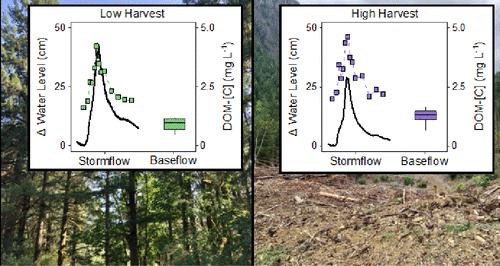当前位置:
X-MOL 学术
›
ACS ES&T Water
›
论文详情
Our official English website, www.x-mol.net, welcomes your feedback! (Note: you will need to create a separate account there.)
Hydrology Predominates Over Harvest History and Landscape Variation to Control Water Quality and Disinfection Byproduct Formation Potentials in Forested Pacific Coast Watersheds
ACS ES&T Water Pub Date : 2024-03-18 , DOI: 10.1021/acsestwater.3c00471 Alyssa K. Bourgeois 1 , Suzanne E. Tank 1 , William C. Floyd 2, 3 , Monica B. Emelko 4 , Fariba Amiri 4
ACS ES&T Water Pub Date : 2024-03-18 , DOI: 10.1021/acsestwater.3c00471 Alyssa K. Bourgeois 1 , Suzanne E. Tank 1 , William C. Floyd 2, 3 , Monica B. Emelko 4 , Fariba Amiri 4
Affiliation

|
Despite the global importance of forested watersheds as sources of drinking water, few studies have examined the effects of forestry on drinking water treatability. Relatively little is known about how the interaction between landscape variation and flow impacts source water quality and what this interaction means for drinking water treatability. To address this knowledge gap, we examined variability in sediments, dissolved organic matter, and disinfection byproduct formation potentials (DBP-FPs) across a range of flow conditions in four small watersheds with contrasting forest harvest histories and soil characteristics on Vancouver Island. Storm event-driven change in streamflow was the primary driver of water quality and DBP-FPs at our sites, with greater changes during stormflow (e.g., a 3-fold increase in dissolved organic carbon concentrations) than those across contrasting watersheds. Flow-driven changes in water quality and DBP-FPs were not significantly different across watersheds with different harvest histories; muted responses may be attributed to widespread second growth forests (i.e., recent harvesting effects may be confounded by historical harvest), forestry practices (e.g., slash burning), or soils with low organic carbon storage. This study suggests that variation in hydrology predominates over harvest history and soil characteristics to drive water quality and DBP-FPs on the east coast of Vancouver Island.
中文翻译:

水文在收获历史和景观变化中占主导地位,以控制太平洋沿岸森林流域的水质和消毒副产品的形成潜力
尽管森林流域作为饮用水源具有全球重要性,但很少有研究探讨林业对饮用水可处理性的影响。关于景观变化和流量之间的相互作用如何影响水源水质以及这种相互作用对饮用水可处理性意味着什么,人们知之甚少。为了解决这一知识差距,我们研究了四个小流域的一系列水流条件下沉积物、溶解有机物和消毒副产品形成潜力 (DBP-FP) 的变化,并对比了温哥华岛的森林采伐历史和土壤特征。暴风雨事件驱动的水流变化是我们现场水质和 DBP-FP 的主要驱动因素,暴风雨期间的变化比对比流域的变化更大(例如,溶解有机碳浓度增加 3 倍)。在具有不同收获历史的流域中,水流驱动的水质和 DBP-FP 变化没有显着差异;反应平淡可能是由于广泛的次生林(即最近的采伐影响可能与历史采伐相混淆)、林业做法(例如砍伐焚烧)或有机碳储存量低的土壤造成的。这项研究表明,水文变化主导了收获历史和土壤特征,从而影响了温哥华岛东海岸的水质和 DBP-FP。
更新日期:2024-03-18
中文翻译:

水文在收获历史和景观变化中占主导地位,以控制太平洋沿岸森林流域的水质和消毒副产品的形成潜力
尽管森林流域作为饮用水源具有全球重要性,但很少有研究探讨林业对饮用水可处理性的影响。关于景观变化和流量之间的相互作用如何影响水源水质以及这种相互作用对饮用水可处理性意味着什么,人们知之甚少。为了解决这一知识差距,我们研究了四个小流域的一系列水流条件下沉积物、溶解有机物和消毒副产品形成潜力 (DBP-FP) 的变化,并对比了温哥华岛的森林采伐历史和土壤特征。暴风雨事件驱动的水流变化是我们现场水质和 DBP-FP 的主要驱动因素,暴风雨期间的变化比对比流域的变化更大(例如,溶解有机碳浓度增加 3 倍)。在具有不同收获历史的流域中,水流驱动的水质和 DBP-FP 变化没有显着差异;反应平淡可能是由于广泛的次生林(即最近的采伐影响可能与历史采伐相混淆)、林业做法(例如砍伐焚烧)或有机碳储存量低的土壤造成的。这项研究表明,水文变化主导了收获历史和土壤特征,从而影响了温哥华岛东海岸的水质和 DBP-FP。



























 京公网安备 11010802027423号
京公网安备 11010802027423号